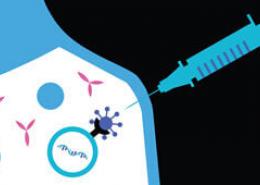MRNA VS. CONVENTIONAL VACCINES

Working Together to Empower Women

Reducing Health Disparities in Latino Communities

Pfizer Women’s Resource Group

Universal vs. Single Payer Healthcare

The novel coronavirus has recently been linked to two serious fungal infections: COVID-19 associated pulmonary aspergillosis (CAPA) and COVID-19 associated mucormycosis (CAM).1 The resurgence of these rare fungal infections has medical personnel concerned.
A 2021 study found that more than 47,000 cases of CAM were reported in just three months in India. And with the Delta variant spreading worldwide, reports suggest that the number of cases is likely much higher.2
Aspergillosis and mucormycosis, which is often, mistakenly, referred to as “black fungus”, existed before COVID-19, though it is rare and primarily affects people with severe illnesses—such as bone marrow transplants or acute myeloid leukemia—and people in the ICU with damage to the lungs.3 However, it has been exacerbated with COVID-19.1,4
Common misconceptions
The term “black fungus” has been used by the public to describe mucormycosis; however, according to Jay Aram, MD, Global Medical Affairs Lead, Anti Infectives at Pfizer, black fungus is actually a different category of fungus that is not associated with CAPA or CAM. Instead of black fungus, the medical community prefers to use “mucor fungi.”
Another common misconception of CAPA and CAM is that they are contagious.3 “This is not true,” says Aram. “These infections develop due to exposure to the fungal the spores—primarily in the air. People do not produce these spores and cannot spread them to others.”
What are CAPA and CAM?
CAPA and CAM are opportunistic secondary infections caused by fungi in patients with severe COVID-19. According to Aram, these infections are considered opportunistic because they are more common in people with an impaired immune system or who have developed lung damage such as acute respiratory distress syndrome.
Both fungal infections are considered rare, however, they can be fatal if left untreated. Of the two, reports indicate that CAM is usually associated with more severe cases as well as a higher mortality rate.1,5 “If left untreated, mortality associated with aspergillosis, or CAPA, may be up to 80 percent,” says Aram. “In mucormycosis, mortality is nearly 100 percent if untreated.”
How does a person get infected with CAPA and CAM?
Fungi, especially the spores of aspergillosis, can be found everywhere in the environment: it can be found in soil, decomposing plant matter, plants, air, food, and water.2 According to Aram, aspergillosis (which is found in household dust, building materials—in addition to soil, plants, food, and water) is approximately10 times more prevalent than the mucor fungi associated with mucormycosis (which are found in the environment as well—such as in soil and decaying organic material.) “We live with them every day, and as immune-competent people, we usually do not have a problem with that,” he says.3
These spores can enter the body in several ways: by inhaling them, swallowing them in food or medicines, or by spores entering wounds and contaminating them. Inhalation is the most common way of coming into contact with these fungi that cause systemic infection.3
Healthy people can usually clear these spores from the body. It becomes a problem when either our immune systems are weakened, or there is damage to the natural human defenses in tissues or the lungs—for instance, with a COVID-19 infection—which can cause an infection to spread.2
What are the risk factors?
Poorly controlled diabetes was reportedly the most common underlying risk factor in patients with CAM in India, where diabetes is more widespread and often left untreated.1 People with diabetes have high blood sugar. This, researchers believe, makes the body a more conducive environment for fungi to grow.2,6
Another risk factor is the use of corticosteroids, which are strong immunosuppressants used to treat severe cases of COVID-19. Corticosteroids have been known to impair the ability of phagocytes (cells that consume harmful bacteria in the body), therefore leaving a person more vulnerable to fungal infections.2,6,7
The environment is also at play. Tropical climates, where it is hot and humid, are prime breeding grounds for fungi to grow.1 And evidence suggests that in India, these mucor fungi are more prevalent, making exposure more likely than in other areas of the world.2
Treatment options
Early intervention is critical for both CAPA and CAM.1 Health care teams and hospital staff are being urged to increase their awareness of these fungal infections. “The earlier you can screen the patient and spot the infection, the better,” says Aram. Screening can include a test that measures galactomannan, a molecule found in the cell wall of Aspergillus fungi. A computed tomography (CT) scan is used to confirm a diagnosis. “Pending confirmation, doctors should treat a patient immediately.”
Research shows that combination medical therapy may be needed.1,5 This includes using antifungal medication in addition to controlling blood sugar and the immediate removal of any dead tissue.2,5 While antifungal medicines have been an effective treatment option for CAPA, there are fewer medicines that work as effectively in CAM.5,6
Future outlook
Due to the spread of the Delta variant, countries could potentially see an increase in fungal infections—not only in India but worldwide. It is important for health care providers to have greater awareness and to be prepared, especially for high-risk patients. Quicker diagnoses, better treatment methods, and more research are needed to control these fungal infections.7
Sources:
Source: Read Full Article